Jack’s Irish holiday
Published in Features, Issue 3 (May/June 2020), Volume 28A New Zealand perspective on the Easter Rising.
By Rory Sweetman
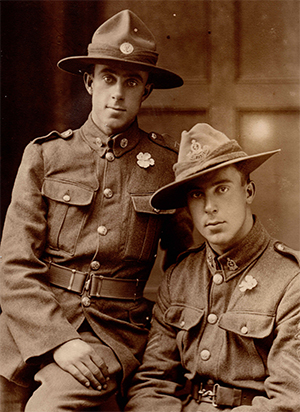
Above: Corporal Jack Garland (seated) with his brother Tom. (Rhondda Garland)
Jack Garland was an orderly with the New Zealand Medical Corps attached to the hospital ship Marama during the First World War. The 21-year-old corporal spent the first few months of 1916 evacuating wounded Allied troops from around the Mediterranean, including many survivors of the disastrous Gallipoli campaign. At Easter, instead of attending the first ANZAC memorial service at Westminster Abbey, Garland and a fellow-Kiwi, Sergeant Fred Nevin, chose to spend their leave in Dublin, taking advantage of the concessionary fare available for military personnel. After booking into their rooms at Wynn’s Hotel in Lower Abbey Street, they began a tour of the city’s sights on Monday 24 April. However, as Garland wrote later to his father, they only got as far as Sackville Street before their holiday came to an abrupt end:
‘We were standing in the main street about 2pm, just about 100 yards from our hotel. Shots were being fired, and a soldier from the Dublin Fusiliers was killed while walking with his young lady. There were thousands of people in the streets, and all of a sudden a large motor car whizzed past us. In it was the noted Countess, dressed in a green uniform. As she went past she fired two shots at us. One went above our heads; the other caught an elderly man in the arm. It seemed to be a signal to the other Sinn Feiners, for bullets started to whizz all round us.’
Garland and Nevin were then approached by another New Zealander, Corporal Alexander Don, who urged them to beat a hasty retreat to the Central Soldiers’ Club in College Street. After its proprietor informed them that ‘all the soldiers had gone over to the [sic] Trinity College’, they crossed the road and the porter unlocked the gates and allowed them to enter.
So began a week of danger and excitement, as the New Zealanders found themselves leading a small garrison in a successful defence of Ireland’s oldest university from a fierce rebel attack launched in the early hours of Tuesday 25 April. Trinity was virtually empty, with most of its potential defenders away for the Easter vacation, so the ragtag assortment of colonial troops chased into its campus was doubly welcome. There were fourteen soldiers—six South Africans, two Canadians, one Australian and five New Zealanders—but only the latter had military experience and rank; four of the five Kiwis were NCOs, while the other nine colonials (all immediately dubbed ‘Anzacs’ by the Trinity authorities) were privates. An acute observer noted that once the shooting started ‘the College authorities faded out and soldiers were in command’.
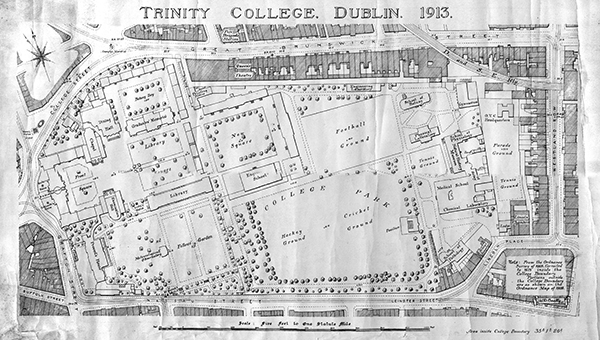
Above: Note the ‘O.T.C. [Officer Training Corps] Headquarters’ at the east end of Trinity’s campus (top right-hand corner), where an armoury of 300 rifles and 5,000 rounds of ammunition was located. By late Monday evening the Anzacs had persuaded their officers to move the contents of the armoury and concentrate their forces in the College’s front quadrangles at the west end (left). (TCD)
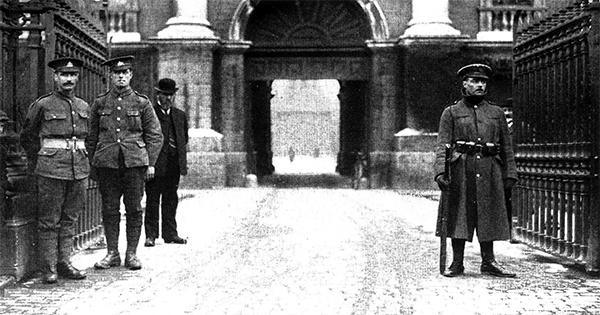
Above: British soldiers standing at Trinity College Front Gate after the Rising. (RIA)
By late Monday evening the Anzacs had persuaded their officers—academics more comfortable with the pen than the sword—to move the contents of the armoury and concentrate their forces in the College’s front quadrangles. The Anzacs offered to act as snipers on the main West Front building, and were guided by the porters to strategic spots on its roof and windows. From these elevated positions they commanded College Green and Nassau, Grafton, Dame, College and Westmoreland Streets, with a line of fire extending across O’Connell Bridge and down Sackville Street. Tired of being a target for rebel snipers, the Anzacs now seized their opportunity to turn the tables, blazing away at anything that moved. ‘We remained on that roof from midnight on Easter Monday till midnight on Thursday,’ Jack Garland recalled, ‘without a wink of sleep—exactly 72 hours.’
The Anzacs arrived just in time to repulse a belated rebel attempt to capture the College, ordered by James Connolly from rebel headquarters in the General Post Office. Ironically, their victory in this three-hour gun battle on early Tuesday morning was not recognised at the time and has escaped the notice of historians ever since. Trinity’s defenders mistook the attack for a rebel attempt to rob the Bank of Ireland (directly across the road). Rebel gunfire from the rooftops of the Fleet Street buildings immediately behind the bank convinced the Anzacs that it was the insurgents’ true objective. Three of the New Zealanders subsequently wrote home claiming credit for having saved the Bank of Ireland, a false trail eagerly followed by Dublin’s newspapers when they resumed publication.
The New Zealanders’ blunder is the more forgivable as they were the only ones to leave a record of the engagement. In fact, they were unusually willing to write and talk about their Easter Week experiences. Composed soon after the events they describe, their letters have the immediacy of eyewitness testimony and give a glimpse of the brutal realities of urban warfare. They also contain elements of fantasy and exaggeration, inflating —and, in Jack Garland’s case, inventing—episodes for the benefit of a colonial audience that had no means of assessing their veracity.
Garland’s long letter is a curious mixture of precision and invention, of verifiable detail and sheer fantasy. In it he recounts the exhausting vigil kept by the Anzacs on Trinity’s West Front building: ‘I left Dublin at 8pm on Tuesday [2 May], after doing nine days’ duty, living on biscuits and water the whole time, and only having about twenty hours’ sleep’. He describes ‘a town in ruins’, with ‘bodies of soldiers, horses, civilians, and Sinn Feiners lying about Sackville Street until Saturday’. His initial claim of being shot at by Countess Markievicz, however, clearly falls into the category of ‘unsustainable’. The New Zealanders were not only displaying Red Cross insignia but were also wearing slouch hats, difficult to distinguish from the Irish Citizen Army outfit that Markievicz herself had designed. She had indeed been a passenger in Kathleen Lynn’s open-topped car on Easter Monday, but this was over two hours earlier and on the other side of the Liffey. Whatever the truth of her possible involvement in the death of Constable Lahiff at St Stephen’s Green, Markievicz is clearly blameless in this case.
On Saturday Nevin and Garland were ordered to guard around 50 prisoners being held in the enclosed courtyard of the Custom House. Curious about why the rebellion had taken place, Nevin spent most of the weekend quizzing the rebel leaders and rank and file. (Frank Thornton, Seamus Daly, William O’Brien and William Brennan-Whitmore later recalled his expressions of sympathy with their cause.) Garland preferred to chat with some of the 300 civilian refugees in the Custom House ‘who had been burnt out of their homes’. Among them was a troupe from the D’Oyly Carte Opera Company, whose scheduled performance at the Gaiety Theatre had been overtaken by events. Their baritone, the Christchurch-born Fred Hobbs, wrote home soon afterwards telling of his meeting with the New Zealand ‘sharpshooters’ who ‘did deadly work’ defending Trinity College.
Three months later, Garland and Nevin were rather surprised to find themselves back in Dublin, as the Marama was ordered to transport 482 Irish casualties from Le Havre. Arriving on 22 July 1916, the ship was met on the wharf and inspected by General Maxwell, and its medical staff driven around the ruins of the city by members of the Automobile Association. One wonders whether the two orderlies were introduced to Maxwell during this visit; if so, it would seem that neither Nevin nor Garland chose to disclose their Easter Week adventures, possibly through embarrassment at so flagrantly breaking Red Cross rules by taking up arms.
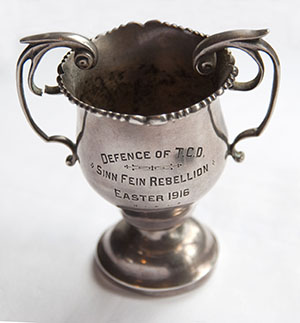
Above: The cup awarded to New Zealand Corporal Alexander Don for his defence of ‘T.C.D. [during the] Sinn Fein Rebellion Easter 1916’. (Hugh Keane)
There is no evidence that Fred Nevin, the son of Irish Catholic parents, followed suit; on returning home, he found that his (largely Irish-descended) Catholic community was coming to embrace a view of the 1916 Rising that reflected Irish nationalist opinion at home. This may explain why Nevin made no mention of his Dublin experiences to his children. By contrast, Garland lectured on ‘My Experiences in the 1916 Rebellion in Ireland’ to his local Orange Lodge in Auckland, while Don frequently regaled the pupils of the preparatory school that he founded with tales of his Irish exploits (unwittingly encouraging the widespread belief that he had served there as a ‘Black and Tan’).
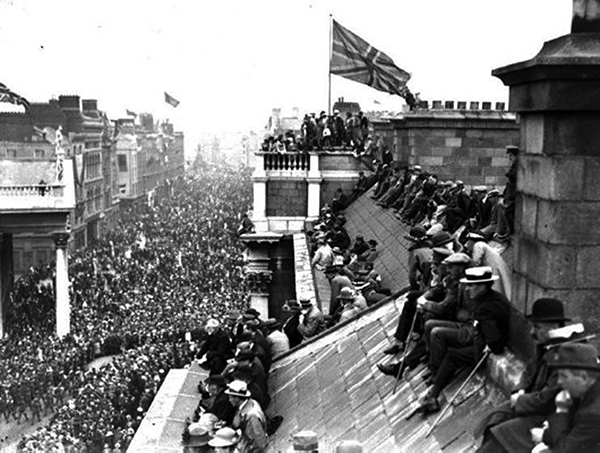
Above: Dublin’s First World War victory parade on 19 July 1919. Crowds gather on the streets and on the roof of Trinity College, where the Anzac snipers had operated to great effect during the Easter Rising in 1916. (RTÉ Stills Library)
Were these New Zealanders—as recent scholarship has suggested—mere pawns in a game of which they knew nothing, dragged into a fight that was none of their business? According to the Irish Times, defeating the rebels in Dublin helped to save the British Empire, so it was only fitting that troops from the British dominions played their part. The imperial dimension, like the First World War itself, should not be seen as a ‘mere exotic backdrop for Irish politics’ in this period. Rather than unwelcome intruders in a domestic quarrel, the colonial soldiers were precisely where and when they were most needed. They had travelled across the world to fight for king and empire, and their ‘blood sacrifice’—at Gallipoli, and subsequently at Delville Wood and Vimy Ridge—matched the Irish ones in Dublin and on the Somme. They acted from a belief in the justice of the Allied cause, and to save themselves from possible German domination. They were keen to demonstrate their loyalty and commitment to the empire, and to ensure that their voice would be heeded in discussions over its future direction. Some of them also hoped that a short victorious war would help to heal their internal divisions. All the above was equally true of Ireland’s constitutional nationalist leaders, who regarded the dominions’ war service as a model to be followed.
The Anzacs’ service to Trinity College has been undeservedly forgotten. Had the College been taken by the Irish Volunteers, its 324th year may well have been its last, as nothing less than a heavy and prolonged bombardment would have sufficed to dislodge and defeat the occupiers. The most apocalyptic vision of Trinity’s potential fate was presented by John Joly, its professor of geology, in an account written while the ruins of Sackville Street were still smouldering:
‘Was this indeed to be, perhaps, the last night of our ancient University? The question is no mere extravagance of the imagination. For so much of the very existence of so venerable a foundation is bound up with its century-old buildings, with its literary and artistic treasures, that sack and conflagration in a single night might obliterate practically all but its memory from the earth. So might perish Ireland’s most priceless treasure—the University of Berkeley, Goldsmith, Burke, Hamilton, and Lecky.’
The College’s official historian dismisses Joly’s fears as ‘misplaced’. ‘There was little need to defend Trinity during Easter Week,’ he argues, since ‘the defence was largely an imagined one.’ For Tomas Irish, the locking of Front Gate is a largely symbolic act and Trinity merely a pantomime villain in the great national drama being staged on the streets of Dublin. A cynical reader might detect here an attempt to drag Trinity out of the British camp, if not quite as far as the GPO then at least into the middle of Sackville Street. The College is depicted as confused and conflicted, overwhelmed by the speed and complexity of events—almost itself a victim of the insurrection.
This interpretation disappointed me, as I was aware of the activities of my fellow Kiwis in the Easter Rising even while a student at TCD in the early 1980s. My subsequent research unearthed several letters written home by the New Zealanders (reproduced in the appendices of Defending Trinity College, Easter 1916: Anzacs and the Rising), which offer new insights into that dramatic week and help to answer some vital questions: how close did Trinity come to being a central battleground in the Rising? How and why did it escape this grisly fate? And—not least—what might have occurred but for the intervention of the colonial troops?
The result is a direct challenge to the historical orthodoxy that Trinity was ‘never directly threatened by the rebel forces’ during the Rising. Rather, it is clear that Joly’s fears were unrealised rather than unrealistic and that without the endeavours of Jack Garland and his comrades during the first two days of the Rising there was a very good chance that Trinity College Dublin would have ended Easter Week as a heap of smoking ruins.
Rory Sweetman lectures in modern Irish history at the University of Otago.
FURTHER READING:
Irish, Trinity in war and revolution 1913–1923 (Dublin, 2015).
Kildea, Anzacs and Ireland (Cork, 2007).
Sweetman, Defending Trinity College, Easter 1916: Anzacs and the Rising (Dublin, 2019).
















